I’ve been spending some time in the Poconos, as I do every summer. A couple weeks ago I found four trout streams I had never fished before. Some photos…
My first brown trout, Lehigh River, taken with a very blond Elk Hair Caddis:
I’ve been spending some time in the Poconos, as I do every summer. A couple weeks ago I found four trout streams I had never fished before. Some photos…
My first brown trout, Lehigh River, taken with a very blond Elk Hair Caddis:
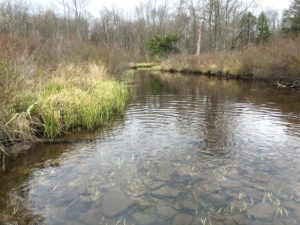 Fishing can be boring, according to some. I certainly experienced what some people would point to as the quintessential boring afternoon of fishing while on a small stream in the Poconos last weekend. My wife and I were in Wilkes Barre for her umptyish high school reunion. I snuck away Saturday to what I was hoping would be an awesome spot, and it probably is sometimes.
Fishing can be boring, according to some. I certainly experienced what some people would point to as the quintessential boring afternoon of fishing while on a small stream in the Poconos last weekend. My wife and I were in Wilkes Barre for her umptyish high school reunion. I snuck away Saturday to what I was hoping would be an awesome spot, and it probably is sometimes.
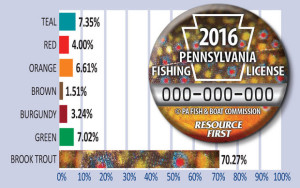 The Pennsylvania Fish and Boat Commission chose a brook trout pattern for their fishing license button. In fact, it won in a landslide.
The Pennsylvania Fish and Boat Commission chose a brook trout pattern for their fishing license button. In fact, it won in a landslide.
Of course, I don’t see any other fish patterns represented. If you’re up against green, red, brown… why would you not win if you were the color “brook trout”?
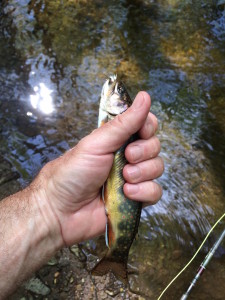
A quick one about catching brook trout near a road…
The Michaux State Forest sits at the very northern end of the formation that is known further south as the Blue Ridge. Other than that, I had little idea where I was going.
I’ve driven past this area dozens of times over the years, between my home in Virginia and points north to visit family in the Poconos and New Jersey. The May/June 2013 issue of Eastern Fly Fishing had an article by Dusty Wissmath about trout streams near the Lincoln Highway and Chambersburg, PA, and it highlighted this state forest. Trouble for me was that I was on my way back to Virginia and didn’t have the article in hand. So, I winged it, found a stream near the road, parked, and rigged up.
The water was low for a mid-May day. When I first took a look, I almost got back in the truck and drove away. Small water, skinny and crystal clear. It looked more like a mid-summer day, and it was in fact in the low 80’s.
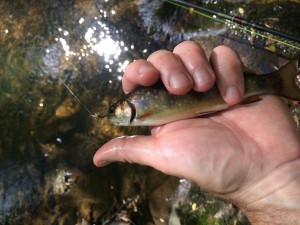
Well, what the hell… I had detoured off I-81 and was wasting time, might as well try it. So I tied on a size 14 Royal Wulff, and caught some fish. Pictured at the top is the first and best brookie I caught. Next is only other one I landed. I fished for maybe twenty minutes, and spent about three minutes “hiking” from my car to the first pool with the first fish, then meandered another ten minutes upstream, saw some splashes and missed a few before the I caught the second. Then I headed home.
There is a lot to explore in this area, including streams in Caledonia State Park, Mont Alto State Park and Pine Grove Furnace State Park. I don’t think the stream I picked was necessarily the top in terms of quality, but I was surprised by the fish I found. That shows that the rest of the area is worth checking out.
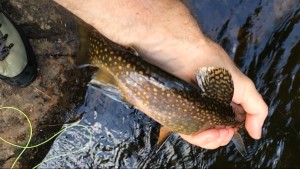
After casting to fish cruising in a good-sized run for an hour and a half, I gave up. It should not be this hard. These are brook trout, damn it! It’s never like that… it’s usually like this:
Hickory Run State Park has been on my hit list for quite some time, so I finally prioritized some things in life and got there. And despite the challenge of what turned out to be an atypical brook trout outing, it was a great afternoon.
The ranger at the park HQ pointed me to the access point for one of the streams I had asked about. The thing about Hickory Run State Park is that there are several streams and all of them have good fishing, so I am told. So I simply picked one, got the intel about where to park, and went for a little hike.
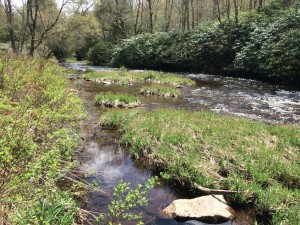
So no, this was not typical small stream brook trout fishing. The water itself was quite a bit larger than the small mountain brooks I’m used to fishing in places like Shenandoah National Park, and the fish were not the usual desperate creatures that hammer anything that looks buggy.
That one pool I worked for an hour and a half crushed me. I watched a couple of good trout (in the twelve inch range) cruising and rising periodically. Everything I threw at them was refused. A Royal Wulff, and parachute Adams, a two fly soft hackle rig, a bead head Hare’s Ear… I added weight, removed weight, drifted again and again and again. Maddening. The soft hackles seemed to generate the most interest. One fish nosed the fly on several passes but did not eat it.
So there I was, kind of pissed. Which was stupid. After all, I was fishing on a beautiful wild trout stream and, regardless of the supposed lack of success, what is better than that on a lovely spring day? But things accumulate over time, and it had been a couple weeks since I had caught a fish. And this was not for having avoided trying — the Shenandoah River a few nights before, a canal in Fort Lauderdale a couple weeks ago, and despite limited success on the Occoquan catching some shad last month, this was all adding up to mediocrity, at best. And now this. I was starting to think I could no longer figure it out. When you fail at something for a stretch, and you know you’ve given it your best shot, it’s more than perplexing. You start to sulk.
I headed upstream, hiking a hundred yards or so above a wide waterfall with a very deep pool at its base, probably a good ten feet deep. The stream here was about twenty feet wide, pretty big water for this area. The run above the falls narrowed and thinned quite a bit. I did the same thing I had done initially at the lower pool, just sat and watched and waited for a while. Finally, I saw a few rises. A fish on the far side of the main current seam was splashing at things. I tied on a size 12 Elk Hair Caddis. He hit but did not take it. More rises directly upstream, a few casts, and no takes. I switched to a size 14 parachute Adams with a neon green post I tied a couple winters ago. Two casts and the fish on the far side of the run ate it. A very nice brook trout, fourteen inches. Outside of Maine or Canada, not sure I could be much happier.
Amazing how one fish can turn your mood around.
The Pennsylvania Fish and Boat Commission is having a disagreement with the state Department of Environmental Protection about the condition of the Susquehanna River. The PFBC says the river is in trouble and should be listed as “impaired,” which will put the river on a “pollution diet” and begin to address the problems. The DEP says there is no proof that the river’s problems are caused by any specific environmental issues. If you read the second link above, it sounds like the DEP may be waiting on more data from USGS and others before it moves on this issue.
We’ve had similar issues in the past seven years or so on the Shenandoah, James, Potomac and other large rivers in Virginia and Maryland. These issues with fish kills, lesions and intersex bass all seem to be caused by a bad combination of environmental factors. So when the DEP says they have no evidence to zero in on specific causes, they are probably correct — technically. And this, of course, misses the whole point.
If you live in Pennsylvania and are concerned about the health of the Susquehanna, read the articles above and contact your representatives.
The Pennsylvania Fish and Boat Commission’s trout stocking info site is a great way to search for where they plan to stock fish in the near future. You can search by county, see the dates, types of fish and the hatcheries used to source each stocking. This is very detailed. I know here in Virginia we “chase” this info on the VDGIF stocking website after the stockings have occurred, and what the PFBC has done is much more useful for planning. I’ve updated the Brook Trout Fishing Guide resources page with this link.
after the stockings have occurred, and what the PFBC has done is much more useful for planning. I’ve updated the Brook Trout Fishing Guide resources page with this link.
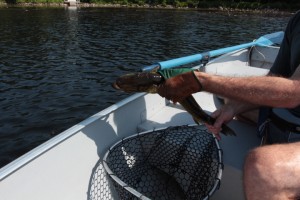
Got to spend some time at the lake in the Poconos this summer. It’s the usual pattern this time of year. May — caught some nice pickerel. Late June — same. Late July and early August — low water, warm temps, the fish are nowhere to be found during the day since they are hanging out DEEP and literally chillin’. Had two bumps this past weekend but no hookups. I even abandoned the fly rod and went with the spinning rod and a Ratt-L-Trap… and everything else in the bag. Only thing left to do was 1) put on a strip of pork rind (I’m not too proud) and 2) get up early. We were having too much fun in the evenings to make (2) workable, and (1) just never happened.
As far as the brook trout, I’ve left them alone recently. It’s just too hot. I think fishing for them when the water temps are in the high 60’s is worse in many ways than catching them when they’re spawning in the fall. Plus, they are so spooky that the two hour round trip hike in the heat and humidity to maybe catch a fish or two also put me off.
The smallmouth are willing, though, if you go very early or at the other end of the day, around sunset. During the heat of the day you can try, but it’s usually (but not always) tough going.
I’m filing this under Fishing Reports. This is not a fishing report per se, but it’s relevant…
Due to a winter that never really arrived, the Mid Atlantic states are experiencing an early spring. Everything has been happening sooner this year. In my yard, the crocuses started blooming over two weeks ago and they’re fading now. That is at least two weeks early. Daffodils are flowering all over, again, two weeks earlier than usual. Following these botanical cues are the bugs, the hatches, and of course the fish. Fishing season is coming sooner this year for sure.
Reports are confirming all of this. Douglas Dear from Rose River Farm in Syria Virginia reported this past week that Quill Gordons have started hatching — two weeks early. Murray’s Fly Shop reported Quill Gordons coming off the water yesterday afternoon in Shenandoah National Park as well. Bryan Kelly at Kelly’s White Fly Shop in Shepherdstown, West Virginia sent an email yesterday about smallmouth bass fishing around Harper’s Ferry on the Potomac and Shenandoah Rivers: “We are starting to guide this month. The fish are moving out of their winter patterns towards pre-spawn behavior. Spawn will be early, and summer patterns will be early… You need to be early…” If this pre-spawn behavior is starting now, that’s closer to three weeks earlier than last year in my neck of the woods along the main stem of the Shenandoah. Incidentally, he goes on to mention that the cicadas will be emerging along the northern section of the Blue Ridge this year, so tie up some big cicada patterns.
So this could be shaping up as a phenomenal early season for us. Hopefully it’s not going to mean that the hot, low clear water conditions come early and stay longer, too. Perhaps we’ll see a nice stretch of cool rains in mid to late spring to break us out of this warm dry pattern we’ve gone through this winter.
The U.S. Environmental Protection Agency has for the first time implicated hydraulic fracturing (“fracking”) in groundwater contamination. Though hardly the last word on this increasingly common practice for extracting natural gas from the ground, and not a blanket indictment of the practice, it is a significant finding. This whole issue is heating up in the east, with Pennsylvania and New York at the center of what has become a well-known controversy in the Marcellus shale region.
My own view is that while it may be possible to do hydraulic fracturing safely in a lot of places, there have been so many allegations of energy companies contaminating groundwater and dumping the wastewater from fracking operations irresponsibly that it’s hard to feel confident about how safe it is. And I still don’t feel comfortable hearing from these companies that there is no reason to worry about the millions of gallons of water and toxic fluids being injected into each gas well since, as they claim, these fluids are put so far below the water table that this stuff will never find its way back up to contaminate our groundwater.
How many times have we heard from companies, “Trust us, it’s safe,” only to find out years later how wrong they were. Once groundwater is contaminated, it’s not easily cleaned up. We don’t even know where a lot of this water goes once it seeps into the ground. We don’t have extensive maps of underground reservoirs and waterways. How can anyone guarantee the safety of the waters we drink and fish without understanding this in much greater detail?
Be circumspect about all this. The brook trout that rely on all this groundwater are watching closely!